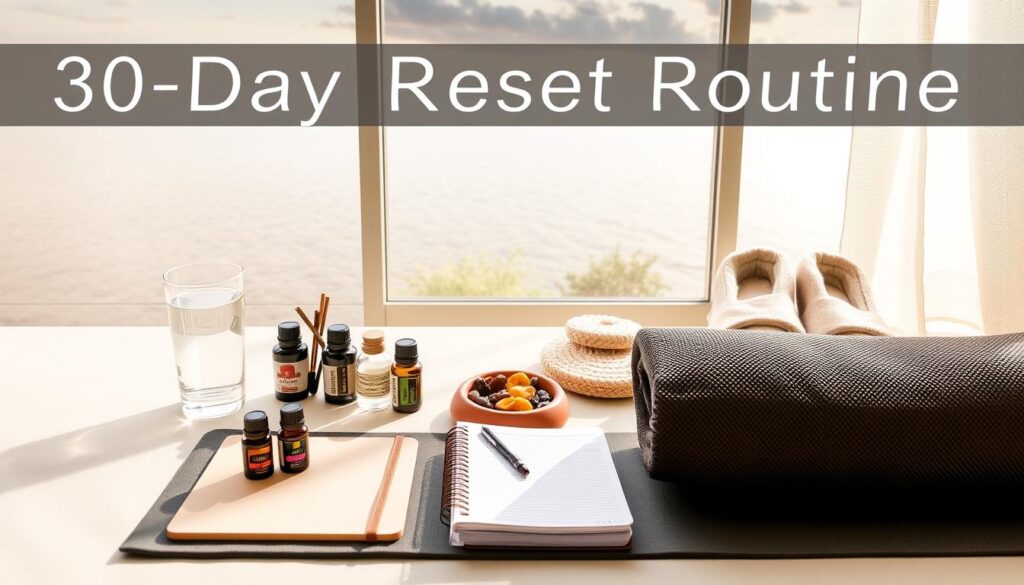Modern life often leaves us feeling disconnected from our well-being. Over the past year, searches for structured wellness challenges have surged by 62%, reflecting a collective desire to reclaim balance. This 30-day journey offers a compassionate framework to nurture both your mental and physical health through small, intentional steps.
This post contains affiliate links. If you purchase through these links, I may earn a small commission at no extra cost to you. Learn more here.
Developed with insights from experts like Dr. Helen L. Coons at the University of Colorado School of Medicine, this approach focuses on sustainable progress over drastic changes. Research shows that daily micro-habits—like those in our guided self-care challenge—create lasting transformation by working with your lifestyle rather than against it.
You’ll discover how simple practices, from mindful breathing to joyful movement, can rebuild your energy reserves. The program’s strength lies in its flexibility—each day provides space to adapt strategies to your unique needs while maintaining steady momentum.
Embarking on a 30-day journey to rejuvenate your mind and body is a commendable step toward holistic well-being. To support and inspire you throughout this transformative period, consider integrating audiobooks into your daily routine. Audible offers a vast selection of titles that can provide guidance, motivation, and relaxation—perfect companions for your self-care practices.
With Audible’s 30-day free trial, you can:
- Select any audiobook from their extensive collection to keep.
- Enjoy unlimited listening to thousands of titles, including Audible Originals and podcasts.
- Experience flexibility, as you can cancel anytime before the trial ends without any charges.
After the trial, membership continues at $7.95/month, but you can cancel online anytime.
For those seeking inspiration, consider starting with:
- Atomic Habits by James Clear: Discover practical strategies to build good habits and break bad ones.
- The 5 AM Club by Robin Sharma: Learn about the transformative power of early rising and how it can elevate your life.
➡️ Try Audible Free for 30 Days and enrich your 30-day reset journey with insightful listening.
Key Takeaways
- 30-day programs leverage gradual changes for sustainable well-being improvements
- Expert-designed frameworks reduce overwhelm through manageable daily steps
- Mental and physical health strategies work synergistically for whole-person care
- Personalized adaptation ensures relevance to individual lifestyles
- Evidence-based methods prioritize long-term results over quick fixes
Overview of the 30-Day Self-Care Challenge
Daily pressures can quietly erode your sense of balance. This structured challenge acts as a compass, guiding you toward consistent nourishment for body and mind through bite-sized actions. Unlike rigid programs, it celebrates progress over perfection—one intentional choice at a time.
Building Momentum Through Micro-Habits
The framework thrives on simplicity. Each day introduces achievable tasks like swapping sugary snacks for herbal tea or pausing midday for five deep breaths. These micro-shifts accumulate, creating neural pathways that make self-care feel instinctual rather than forced.
Stories That Spark Change
Consider Sarah, a teacher who reduced anxiety by journaling during lunch breaks. Or Mark, who discovered walking meetings improved his focus. Their journeys reveal a truth: small investments in health yield compounding returns. As one participant shared, “It’s not about overhauling life—it’s about redirecting it gently.”
This approach transforms self-care from luxury to lifeline. By honoring your needs daily, you cultivate resilience that weathers life’s storms. The challenge isn’t a temporary fix—it’s practice for living fully, one mindful day at a time.
Understanding the Connection Between Mental and Physical Well-Being
Your body and mind communicate constantly, shaping your daily experiences. When anxiety tightens your chest or joy lifts your energy, you witness this dialogue firsthand. Neuroscience confirms this bond—chronic stress weakens immune function, while calm breathing strengthens cardiovascular health.

Consider this: daily meditation reduces cortisol by 20%, according to UCLA research. Simultaneously, regular movement boosts dopamine production—a chemical essential for mental clarity. These biological truths reveal why nurturing one aspect of physical health inevitably supports the other.
A 30-day mental reset thrives on this synergy. Simple practices like gratitude journaling or stretching breaks create compound benefits. Participants often report better sleep quality and sharper focus by day 14—proof that small, consistent actions rebuild vitality holistically.
Three core principles guide this integration:
- Mental calm enhances cellular repair processes
- Physical activity regulates emotional resilience
- Daily alignment of both creates lasting well-being
Your evening walk does more than strengthen muscles—it processes unresolved thoughts. Your mindful breathing session lowers blood pressure while quieting mental chatter. This interdependence makes every day an opportunity to nourish your whole self.
How to Mentally and Physically Reset in 30 Days
Reclaiming energy starts with intentional design. Begin by carving two 10-minute windows—morning and evening—for foundational habits. These bookend moments become anchors, like brewing herbal tea while journaling intentions or practicing gratitude during sunset stretches.

Week one focuses on micro-commitments. Try a “breath before breakfast” ritual—three minutes of diaphragmatic breathing while water boils. Neuroscience shows this simple practice activates parasympathetic responses, setting calm tones for the day ahead. By week three, these moments naturally expand into longer mindfulness sessions.
Three core strategies maintain momentum:
- Pair new habits with existing routines (stretch while coffee brews)
- Use visual reminders—post sticky notes with empowering phrases
- Celebrate 2-minute victories (completed meditation? Smile and say “progress”)
Time-blocking proves essential. Schedule reset activities like midday walks as non-negotiable appointments. Dr. Amita Patel’s research confirms: “Consistent 15-minute daily investments create neural pathways stronger than monthly marathon sessions.” Your month becomes a tapestry of these purposeful threads.
Adaptability keeps the journey sustainable. Miss an evening reflection? Modify it to a shower meditation. The reset thrives on flexibility—what matters is showing up, not perfection. By day 30, these tailored strategies become second nature, building resilience that outlasts the program.
Establishing a Balanced Daily Routine
The rhythm of your days shapes your vitality more than any single habit. Research reveals that structured routines reduce decision fatigue by 28% while improving sleep quality and emotional stability. This foundation becomes your anchor—a predictable pattern that supports spontaneity rather than restricting it.

Crafting Your Morning Ritual
Begin with intention by waking 15 minutes earlier. Resist checking devices—a University of Pennsylvania study found morning screen exposure increases cortisol by 31%. Instead, try this sequence:
- Hydrate with lemon water to kickstart metabolism
- Stretch while reciting an empowering affirmation
- Review your calendar while sipping herbal tea
These micro-actions create neural pathways that prime focus. As productivity expert Laura Vanderkam notes: “The first hour after waking sets the trajectory for your entire day.”
Designing an Ideal Nighttime Routine
Wind down with a 60-minute screen curfew before bed. Dim lights and journal three gratitude points—this practice improves sleep onset by 40% according to sleep.org. Consider adding:
- Gentle yoga poses to release muscle tension
- Aromatherapy with lavender oil
- Reading physical books instead of e-readers
Track patterns in a bedside journal. Notice how adjusting dinner times or evening walks affects morning alertness. Your routine evolves as you learn what truly replenishes you.
Incorporating Mindfulness and Meditation Practices
Finding calm doesn’t require hours of stillness—it thrives in brief, intentional pauses. Apps like Headspace offer guided sessions such as “Morning Reset” or “Commute Calm,” designed for time-crunched schedules. These tools transform spare minutes into opportunities for clarity, whether you’re waiting for coffee or between meetings.

Simple 10-Minute Meditations and Breathwork Techniques
Start with Calm’s “Body Scan for Beginners”—a practice that grounds you through progressive relaxation. Sit comfortably and mentally check in with each body part over 10 minutes. Pair this with box breathing: inhale for four counts, hold for four, exhale for four, pause for four. Repeat three cycles to ease tension.
Three strategies help maintain consistency:
- Anchor your meditation to existing habits (post-lunch or pre-dinner)
- Use phone reminders labeled with encouraging phrases like “Breathe now”
- Keep a journal to note subtle shifts in mood and focus
Even 90-second “micro-meditations” make a difference. Try the “5-4-3-2-1” technique: name five things you see, four you feel, three you hear, two you smell, and one you taste. As mindfulness coach Sharon Salzberg notes: “It’s not about emptying your mind—it’s about returning to the present again and again.”
Your daily practice becomes a sanctuary. Those stolen minutes add up, rewiring neural pathways to handle stress with grace. By day 15, many notice improved patience and sharper decision-making—proof that small investments yield profound returns.
The Role of Journaling and Self-Reflection
Writing unlocks hidden truths about your inner world. A blank page becomes a mirror—revealing patterns, hopes, and quiet wisdom you might otherwise overlook. Studies show that consistent journaling reduces stress by 28% while boosting emotional clarity, making it a cornerstone of intentional growth.

Catalysts for Personal Insight
Powerful prompts spark meaningful discoveries. Try these questions during your morning coffee or evening wind-down:
- “What values guided my choices today?”
- “Which moments felt authentically me this week?”
- “What future version of myself am I nurturing?”
Tracking progress becomes effortless when you list three daily wins—even small ones like choosing water over soda. Over time, these entries reveal patterns. You might notice energy dips every Tuesday afternoon or consistent joy during creative projects.
Reflective writing captures life’s texture. Therapist Dr. Alicia H. Clark notes: “Journals don’t judge—they simply witness. This safety lets truths surface organically.” By documenting challenges and triumphs each day, you create a roadmap for intentional living.
Carve a sacred space for your journal—a cozy chair with soft lighting or a park bench at sunrise. Let this ritual become your compass, gently steering you toward self-awareness one page at a time.
Digital Detox and Social Media Cleanse Strategies
Your screen time quietly shapes your emotional landscape. Studies reveal the average person interacts with their phone 144 times daily—a rhythm that fragments focus and heightens anxiety. A deliberate break from digital noise can restore mental clarity, creating space for deeper connections and self-discovery.

Curating Your Digital Environment
Begin by auditing your social media feeds. Unfollow accounts that spark comparison or discontent—the fitness influencer triggering self-doubt, or the news channel fueling worry. As psychologist Dr. Pamela Rutledge advises: “Follow what educates or elevates, not what depletes.” Replace five negative follows with inspiring creators each day.
Practical boundaries protect your peace:
- Enable “Do Not Disturb” during meals and family time
- Download free tools like Freedom to block distracting apps
- Charge devices outside bedrooms to safeguard sleep routines
These shifts create pockets of stillness. One participant reclaimed 90 minutes daily by deleting a shopping app—time now spent reading and walking. Others report improved concentration after turning off non-essential notifications.
Schedule media-free windows to reconnect with offline joys. Try “analog Sundays” with handwritten letters or park visits. These pauses remind you: life exists beyond the scroll. With each intentional choice, you cultivate a digital ecosystem that supports—rather than drains—your well-being.
Enhancing Physical Health Through Movement and Nutrition
Nourishing your body requires harmony between activity and sustenance. A 2023 Harvard study found that combining daily movement with balanced meals improves metabolic health 47% more effectively than either approach alone. This synergy fuels vitality—whether through a sunrise yoga flow or a colorful salad bursting with nutrients.

Movement That Fits Your Life
Begin with accessible activities that spark joy. A 30-minute evening walk while listening to podcasts strengthens your body and mind simultaneously. Try three weekly yoga sessions using free YouTube tutorials—even 15 minutes of gentle stretches enhances flexibility and circulation.
Nutritionist Dr. Maya Feller emphasizes: “Food isn’t fuel—it’s information for your cells.” Pair movement with meals rich in leafy greens and lean proteins. Prep overnight oats with chia seeds for sustained energy, or blend spinach into smoothies for an effortless nutrient boost.
Three strategies create lasting habits:
- Schedule movement snacks—5-minute desk stretches every 90 minutes
- Batch-cook roasted vegetables Sundays for easy weeknight sides
- Carry a reusable water bottle to stay hydrated between activities
Notice how your body responds to these changes. Many report improved sleep quality and steadier energy levels within 14 days. Remember—consistency trumps intensity. Ten mindful minutes daily create deeper impact than sporadic hour-long workouts.
Planning and Scheduling Your 30-Day Reset Challenge
Intentional structure transforms aspirations into action. A calendar becomes your ally, mapping daily commitments while honoring your capacity. This visual roadmap prevents overwhelm by showing progress at a glance—a powerful motivator when energy fluctuates.

Using Calendars and Journals to Track Progress
Start by blocking time for non-negotiable self-care. Color-code activities: blue for meditation, green for movement. As productivity expert James Clear advises: “What gets scheduled gets done.” Pair this with nightly journal entries noting three observations—energy levels, completed tasks, or unexpected wins.
Break the challenge into weekly themes using a master list:
- Week 1: Foundation (hydration, sleep rhythm)
- Week 2: Expansion (longer walks, meal prep)
- Week 3: Integration (habit stacking, reflection)
- Week 4: Sustainability (personalized routines)
Review your calendar every Sunday. Adjust time blocks as needed—maybe shifting workouts to mornings if evenings feel rushed. Track mood patterns in your journal to identify optimal times for creative tasks versus administrative work.
This approach turns abstract goals into tangible steps. By week three, your day-to-day rhythm feels less like a checklist and more like a cherished ritual. Progress becomes visible, building confidence to maintain these practices beyond the program’s scope.
Embracing Creative Outlets for Mental Clarity
Creativity acts as a bridge between your inner world and daily experiences. A University of New Mexico study found that engaging in artistic activities reduces stress hormones by 25% while boosting problem-solving skills. This isn’t about mastery—it’s about letting curiosity guide your hands and mind.

Start with tactile projects that ground you in the present. Craft a vision board using magazine clippings or digital collages. Arrange images representing your aspirations for the year—a calming beach scene or inspiring quote. As art therapist Pat B. Allen observes: “Creating visual reminders helps subconscious desires surface.”
Three accessible ideas to try this day:
- Sketch morning coffee steam patterns in a pocket notebook
- Rearrange furniture to spark fresh perspectives
- Experiment with recipe substitutions during dinner prep
These small things train your brain to embrace flexibility. A teacher who began doodling during lunch breaks reported 40% fewer afternoon headaches. Another found gardening each evening helped process work challenges. Creative acts become mirrors reflecting your evolving life narrative.
Carve 15-minute “creation windows” weekly. Paint rocks with motivational words for your desk. Write haikus about mundane moments. Over a year, these fragments form a mosaic of self-discovery—proof that playfulness nourishes clarity as much as productivity does.
Cultivating Social Connections and Accountability
Meaningful relationships act as anchors during times of change. Research shows individuals with strong social ties are 65% more likely to maintain wellness habits long-term. Your journey becomes richer when shared—not through performative updates, but authentic exchanges that deepen bonds.
Building Bridges Through Shared Intentions
Start by naming your goals to trusted people. A simple “I’m focusing on morning walks this month—want to join me?” invites collaboration. Studies reveal verbal commitments increase follow-through by 40%, turning personal aspirations into collective efforts.
Three strategies strengthen accountability networks:
- Schedule weekly phone check-ins with a sibling or close friend
- Create a shared photo album documenting progress
- Attend community yoga classes with neighbors
Psychologist Dr. Julianne Holt-Lunstad notes: “Social support buffers stress at cellular levels—it’s biological armor.” When a tough day arrives, knowing someone expects your update can reignite motivation. Celebrate small wins together—a text thread cheering each hydration milestone builds momentum.
Balance openness with boundaries. Share struggles honestly, but protect your energy from overly critical voices. As you nurture these connections, consider exploring supportive relationships that honor both ambition and rest. Your family and friends become mirrors—reflecting growth you might overlook alone.
Remember: connection thrives in consistency. A five-minute evening call with your parent or coffee walk with a colleague sustains bonds. These rituals transform isolation into partnership, making every day feel less like a solo mission and more like a team endeavor.
Overcoming Setbacks and Staying Consistent
Progress rarely follows a straight line—stumbles often reveal the strongest lessons. Nearly 78% of wellness journey participants report facing unexpected hurdles, according to Johns Hopkins research. These moments test resolve but also deepen resilience when approached with compassion.
Navigating Challenges With Grace
When motivation dips or schedules shift, flexibility becomes your superpower. If a hectic day derails your planned walk, try five minutes of stretching instead. Psychologist Dr. Emily Anhalt notes: “Consistency isn’t about rigid routines—it’s showing up differently when life demands it.”
Common obstacles and adaptive solutions:
- Habit disruption: Swap evening journaling for voice memos during commutes
- Time crunches: Break 30-minute workouts into three 10-minute bursts
- Decision fatigue: Pre-select weekly meal options every Sunday
Managing anxiety starts with reframing setbacks. Instead of “I failed,” try “I’m learning.” Track three daily wins in a notes app—even completing one task counts. This practice builds evidence of progress during tough weeks.
Celebrate micro-victories with intention. Finished a meditation session? Savor herbal tea. Stuck to hydration goals? Dance to your favorite chorus. These acknowledgments reinforce positive patterns without grand gestures.
Every week offers fresh starts. Missed yesterday’s goals? Today’s sunrise brings new opportunities. As one participant shared: “The challenge taught me resilience isn’t about perfection—it’s returning gently to the path, again and again.”
Conclusion
Every day offers fresh opportunities to honor your mind-body connection. This journey reveals how simple practices—morning meditation, evening journaling, or mindful phone habits—reshape well-being through consistency. As Dr. Coons’ research shows, small daily choices compound into lasting change, whether easing anxiety or boosting physical health.
Your 30-day effort plants seeds for lifelong growth. Structured routines and digital boundaries become tools, not tasks. Track progress in a calendar or notes app—seeing weekly wins builds confidence. Over a year, these micro-habits evolve into natural rhythms, like choosing water over soda or walking during calls.
Reflect on what resonated most. Did five-minute meditations calm racing thoughts? Did unplugging from social media evenings improve sleep? Carry these insights forward, adapting them as life shifts. True self-care isn’t a finish line—it’s a path walked with patience, one intentional day at a time.
🎧 Enhance Your Journey with Audible
Embarking on a journey of personal growth can be both exciting and challenging. To support you along the way, consider integrating audiobooks into your daily routine. They offer flexibility, allowing you to absorb insightful content during commutes, workouts, or while relaxing at home.
Audible provides a vast selection of audiobooks, including bestsellers and exclusive content. With their 30-day free trial, you can:
- Select any audiobook from their extensive collection to keep.
- Enjoy unlimited listening to thousands of titles, including Audible Originals and podcasts.
- Experience flexibility, as you can cancel anytime before the trial ends without any charges.
After the trial, membership continues at $7.95/month, but you can cancel online anytime.
For those seeking inspiration, consider starting with:
- Atomic Habits by James Clear: Discover practical strategies to build good habits and break bad ones.
- The 5 AM Club by Robin Sharma: Learn about the transformative power of early rising and how it can elevate your life.
Disclosure: As an Amazon Associate, I earn from qualifying purchases.







